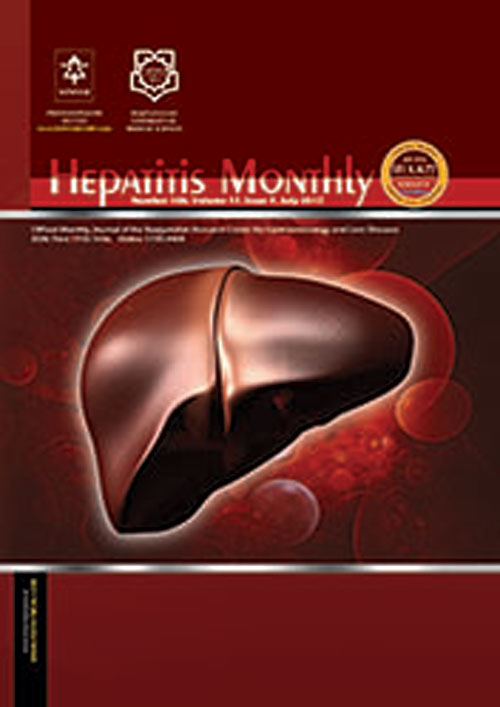فهرست مطالب

Hepatitis Monthly
Volume:19 Issue: 3, Mar 2019
- تاریخ انتشار: 1398/01/31
- تعداد عناوین: 3
-
-
Page 1BackgroundIn the recent years, hepatocellular carcinoma (HCC) has become one of the first causes of cancer mortality in humans. Among the issues explaining this appalling situation the lack of early biomarkers occupies a prominent position. In patients with tumors, free circulating DNA originating from tumor cells represents a promising material for the early detection of the disease. In HCC, two mutations, R249S on TP53 and -124C>T in TERT promoter, are potentially present in large subsets of patients and could be considered as good candidate biomarkers. Tunisia is a subtropical country where persistent infections with hepatitis virus represent a significant burden of diseases and food contamination with mycotoxins has been consistently detected.MethodsIn a pilot study, using the droplet digital PCR (ddPCR) technique, blood samples from 47 patients with HCC and 51 control individuals were evaluated for the presence of the TP53 or TERT mutants in the bloodstream.ResultsWe observed that 19.1% and 14.9% of the patients with HCC were carrying TP53 or TERT mutants, while 47.1% and 5.8% of controls were positive for the same biomarkers (P = 0.005 and P = 0.18, ns). Most (66.6%) HCC patients with TP53 R49S were coming from the region of Nabeul (North East).ConclusionsThis preliminary analysis indicates that droplet digital might be useful for the diagnosis of HCC or screening high-risk subjects in the North African context. In addition, our results confirm previous data obtained by foodstuffs analyses suggesting that a sizeable proportion of the middle-aged Tunisian population is or has been significantly exposed to aflatoxin B1. Larger studies are now mandatory to confirm and refine these preliminary data.Keywords: Hepatocellular Carcinoma, AflatoxinB1, TP53, TERT, Mutations, Droplet Digital
-
Page 2In chronic hepatitis C treatment, direct acting antivirals have a strong effect and are well tolerated since 2014, yet it is unclear whether resource-constrained countries have the same achievement. This study aimed at evaluating direct acting antivirals used to treat Turkish chronic hepatitis C patients between the years of 2016 to 2017. Within the one-year period, 101 out of 105 patients reached a sustained virological response rate. The type of direct acting antivirals and treatment length were chosen according to the Health Implementation Guideline of Turkey. The analyses of effectiveness according to therapeutic regimes showed the following sustained virological response rate: Ledipasvir/sofosbuvir and +/-; ribavirin (97%), ombitasvir/paritepravir/dasabuvir and +/-; ribavirin (100%) and sofosbuvir + ribavirin (100%). One patient had virological relapse on the 12th week by the end of the therapy. In this patient, cross-resistance mutation Y93H was specified for the NS5A region. On the other hand, amino acid changes, S282G and C316S, were determined in the NS5B region. The adverse effects were 22% in all patients. Most of them were mild or moderate. The researchers concluded that the results of the highly efficient and well-tolerated therapy with direct acting antivirals could be examples in resource-constrained countries. In addition, resistant variants should be detected after unsuccessful treatment in the management of new therapy options.Keywords: C Virus, Sofosbuvir, Ledipasvir, Ombitasvir, Drug Resistance
-
Page 3BackgroundThe causes of cryptogenic cirrhosis, as one of the most important unresolved issues in the management of liver failure, remains unknown. Hepatitis B virus (HBV) infection with a high impact in Iranian liver graft recipients may have a key role in introducing and developing cryptogenic cirrhosis, especially in the occult form. Therefore, the prevalence of occult HBV infection was evaluated in liver transplant recipients with cryptogenic cirrhosis.MethodsIn this cross-sectional study, a total of 127 liver transplant recipients with cryptogenic cirrhosis were recruited. The serum samples of patients were evaluated for immunological HBV infective markers, using enzyme-linked immune sorbent assay (ELISA) methods. Moreover, immunohistochemistry (IHC) was used for detection of HBsAg in liver tissue sections. Collected serums and liver tissue samples were also examined for HBV genomic DNA, using a qualitative polymerase chain reaction (PCR) technique.ResultsHBsAg was not found in any studied liver tissue or serum samples. However, HBV genomic DNA was found in the liver tissue and serum samples of 35.4% and 36.2% of the liver transplant patients with cryptogenic cirrhosis, respectively. Occult HBV infection was found in 35.4% of the patients with cryptogenic cirrhosis. Seropositive and seronegative types of occult HBV infection were found in 82.2% and 17.8% of the patients, respectively.ConclusionsFindings of the high prevalence of molecular and immunological markers of HBV infection, especially occult ones, in liver transplanted patients with cryptogenic cirrhosis was re-enforced. These results indicate the important role of occult HBV infection in the pathogenesis of cryptogenic cirrhosis, which needs to be evaluated in the future through comprehensive studies.Keywords: Hepatitis B Virus_Cryptogenic Cirrhosis_Occult Infection_Liver Transplantation

